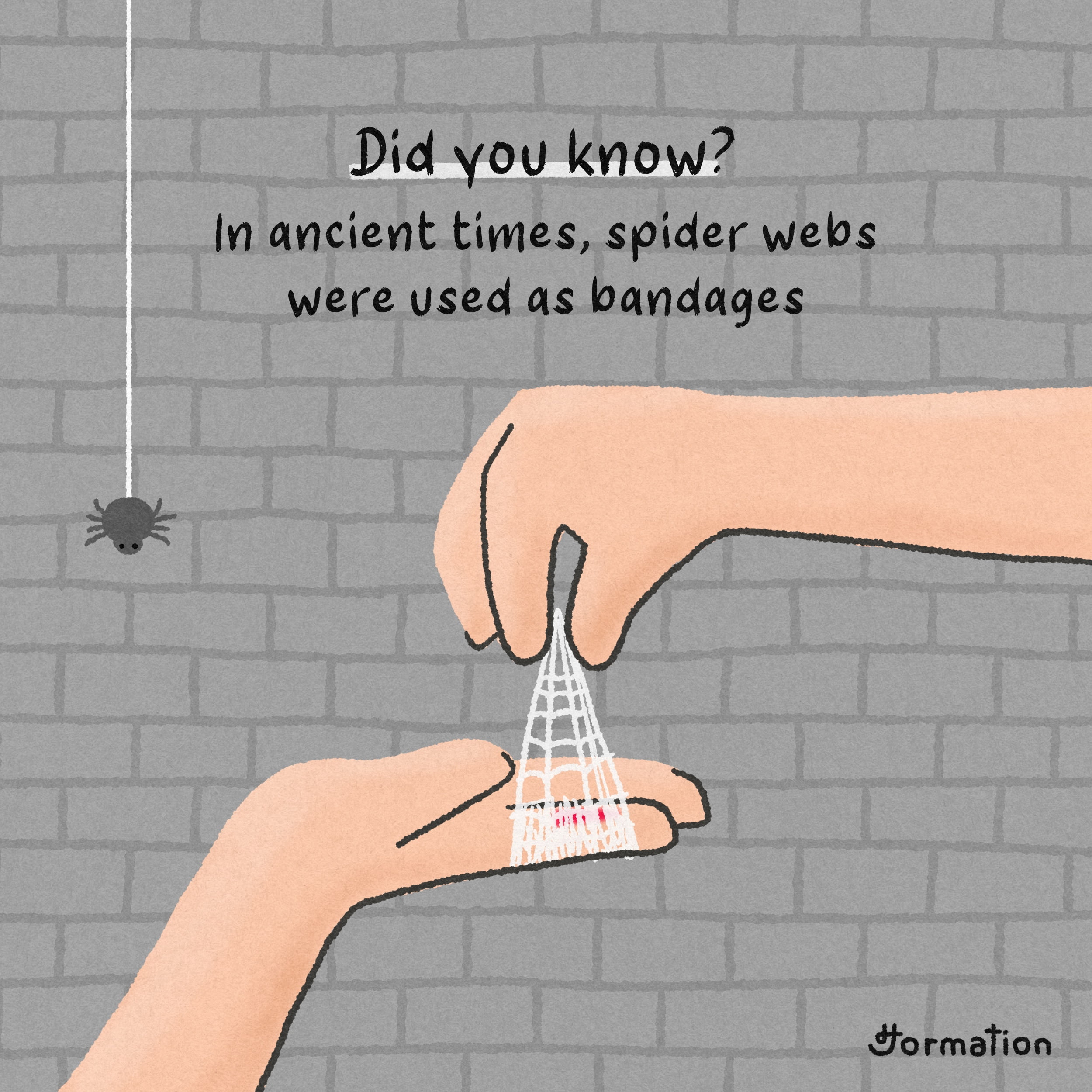Spider webs cannot be used as bandages as they lack the necessary properties for wound care. Although spider silk is strong, it does not possess the qualities required for medical bandages.
People have experimented with spider silk for various applications, but using it as a bandage is not feasible due to its limitations. While spider silk is fascinating for its strength and elasticity, it is not a suitable alternative to traditional bandages in the medical field.
Researchers continue to explore the potential uses of spider silk, but currently, it is not a viable option for wound management.
The Marvel Of Spider Silk
Unique Properties Of Spider Silk
Spider silk is an extraordinary material with incredible strength and flexibility. It is stronger than steel of the same diameter and can stretch up to five times its original length without breaking.
This remarkable combination of strength and elasticity makes spider silk an ideal candidate for medical applications, including wound care and bandaging.
Historical Use In Medicine
Throughout history, various cultures have utilized spider silk for medicinal purposes. Ancient Greeks and Romans reportedly used spider webs to dress wounds due to the silk’s antibacterial properties.
Even today, researchers are exploring the potential of spider silk as a biocompatible material for medical devices, including sutures and artificial ligaments.
Spider Webs And Modern Medicine
When it comes to innovative solutions in wound healing, nature has often been a source of inspiration. One such example is the use of spider webs in modern medicine. Spider silk, known for its incredible strength and flexibility, has caught the attention of scientists and researchers for its potential applications in wound care. Through extensive research and advancements in biotechnology, spider silk is being explored as a possible alternative to traditional bandages.
Research On Spider Silk For Wound Healing
Extensive studies have been conducted to understand the properties of spider silk and its potential benefits in wound healing. Scientists have discovered that spider silk possesses remarkable antimicrobial properties, which can help prevent infection in wounds. Additionally, its biocompatibility and biodegradability make it an attractive material for medical applications.
In recent years, researchers have been able to successfully replicate spider silk proteins through genetic engineering, allowing for the production of silk fibers in laboratories. These artificially produced spider silk proteins can be used to create bandages that mimic the natural properties of spider silk.
Innovations In Biotechnology
Thanks to advancements in biotechnology, scientists are now able to harness the potential of spider silk for wound healing. By extracting the silk proteins from spiders or producing them through genetic engineering, they can create bioactive bandages that promote faster wound healing.
One approach involves incorporating antimicrobial agents into the spider silk bandages, enhancing their ability to prevent infection. Another innovation is the development of bandages that release growth factors, which can stimulate tissue regeneration and accelerate the healing process.
Furthermore, researchers are exploring the use of spider silk scaffolds, which can provide a three-dimensional framework for cells to grow and regenerate. These scaffolds have the potential to revolutionize tissue engineering and regenerative medicine by promoting the formation of new tissues.
While spider webs may not be directly used as bandages, the remarkable properties of spider silk are being harnessed through biotechnology to create innovative wound care solutions. As research continues to progress, the potential applications of spider silk in modern medicine are becoming increasingly promising.
How Spider Silk Promotes Healing
Spider silk has long been admired for its remarkable strength and flexibility, but recent research has revealed another surprising attribute: its ability to promote healing. The unique properties of spider silk make it an intriguing candidate for potential medical applications, including the use of spider webs as bandages. Understanding how spider silk promotes healing can shed light on its potential as a natural remedy for wounds and injuries.
Bio-compatibility And Cell Growth
Spider silk’s bio-compatibility and ability to support cell growth are key factors in its healing-promoting properties. Its structure and composition make it well-suited for interacting with human cells, promoting the growth of new tissue and facilitating the healing process. The biocompatible nature of spider silk reduces the risk of adverse reactions, making it a promising material for medical applications.
Antimicrobial Effects Of Spider Silk
Another remarkable aspect of spider silk is its antimicrobial effects, which can help prevent infections in wounds and injuries. The natural properties of spider silk inhibit the growth of harmful bacteria, reducing the risk of complications during the healing process. This antimicrobial action contributes to the potential of spider silk as a natural bandage material, offering protection against infections without the need for additional chemical treatments.

Credit: www.facebook.com
The Process Of Creating Medical Products
Spider webs, rich in antimicrobial properties, are being explored for medical bandage development. Scientists are intrigued by their potential to create bandages that could aid in faster wound healing and prevent infections. The process involves extracting and processing the web fibers for safe and effective use in the healthcare industry.
Harvesting And Synthesizing Spider Silk
Spider silk, known for its incredible strength and flexibility, has shown great potential in the field of medical products. Harvesting and synthesizing spider silk involves a meticulous process that begins with the collection of spider webs. These webs are carefully harvested from spiders raised in controlled environments. The collected silk is then purified to remove any impurities and processed to obtain the desired consistency and strength. This refined spider silk can then be used to create a variety of medical products, ranging from bandages to artificial tendons.
Designing Spider Silk Medical Devices
Designing spider silk medical devices requires a deep understanding of the properties and capabilities of spider silk. Scientists and engineers collaborate to create innovative solutions by harnessing the unique characteristics of spider silk. This involves careful consideration of the specific medical applications, such as wound healing or tissue regeneration. Spider silk can be woven into intricate patterns or combined with other materials to enhance its functionality. The resulting medical devices are not only biocompatible but also possess remarkable strength and elasticity, making them suitable for a wide range of medical purposes.
Clinical Trials And Studies
Research into the potential of spider webs as bandages has led to documented cases of wound healing and ongoing research and trials.
Documented Cases Of Wound Healing
Several documented cases have shown the effectiveness of spider silk in wound healing. In a study published in the Journal of the Royal Society Interface, researchers found that spider silk contains properties that promote tissue regeneration and wound closure.
Additionally, a case study in the Journal of Arachnology detailed the successful use of spider silk bandages in treating chronic wounds, with remarkable improvements in healing rates and reduced risk of infection.
Ongoing Research And Trials
Ongoing clinical trials and research are focused on further understanding the mechanisms by which spider silk promotes wound healing. Scientists are exploring the potential of leveraging spider silk’s unique properties to develop advanced wound dressings and bandages.
Furthermore, research institutions and pharmaceutical companies are collaborating to conduct large-scale clinical trials to assess the safety and efficacy of spider silk bandages in diverse wound healing scenarios.
Challenges In Spider Silk Applications
Developing spider silk for bandages faces various hurdles.
Ethical And Environmental Concerns
Harvesting spider silk ethically raises challenges due to arachnids’ nature.
Scaling Production For Medical Use
Large-scale spider silk production is complex for medical applications.
Potential For Future Medical Breakthroughs
Spider silk has shown promise in wound healing due to its unique properties. Researchers are exploring the potential for spider webs to be used as bandages.
Expanding The Use Of Spider Silk
Spider silk can be utilized in various medical applications beyond bandages, such as sutures and artificial ligaments.
Cross-disciplinary Innovations
The collaboration between biologists and engineers can lead to groundbreaking advancements in utilizing spider silk for medical purposes.

Credit: www.reddit.com
Patient Stories And Testimonials
Spider webs, with their natural antibacterial properties, have been considered as potential bandage material. Patient stories and testimonials have highlighted the potential of spider silk in wound care, prompting further research into its medical applications. These accounts offer valuable insights into the use of spider webs as bandages.
Recovery Narratives
One patient shared a remarkable story about how spider web bandages aided in their wound healing.
Another individual described how the use of spider silk bandages accelerated their recovery process significantly.
Quality Of Life Improvements
Patients reported enhanced comfort and faster healing with spider silk bandages.
Improved mobility and reduced scarring were also noted by those who used spider web bandages.

Credit: www.facebook.com
Frequently Asked Questions
Can Spider Webs Really Be Used As Bandages?
Yes, spider webs can be used as bandages because of their antibacterial and antifungal properties.
How Do You Apply Spider Webs As Bandages?
To apply spider webs as bandages, you need to wrap the web around the wound and tie it securely.
Is It Safe To Use Spider Webs As Bandages?
While spider webs have antibacterial properties, it’s important to note that not all spider webs are safe to use as bandages. It’s best to consult a medical professional before using spider webs as a bandage.
Conclusion
Spider webs have been used for centuries as a natural remedy to stop bleeding. Recent studies have shown that spider silk is strong, biodegradable and has antibacterial properties. However, the use of spider webs as a bandage is not recommended due to the risk of infection and allergy.
While it is an interesting concept, modern medicine has advanced enough to provide safer and more effective alternatives.
Related posts:

I’m MD Tanvir, and I bring years of expertise gained from working closely with pest control companies to the forefront. My journey in the industry has inspired me to launch Bug Battler, a platform aimed at equipping people with the know-how to combat pests autonomously. Through Bug Battler, I aim to empower individuals with practical insights to tackle pest infestations effectively.

